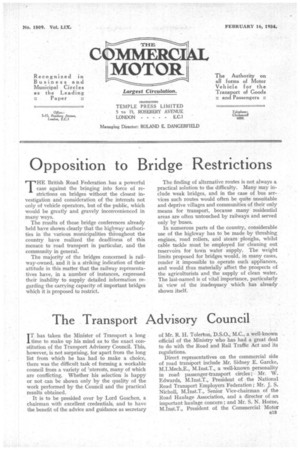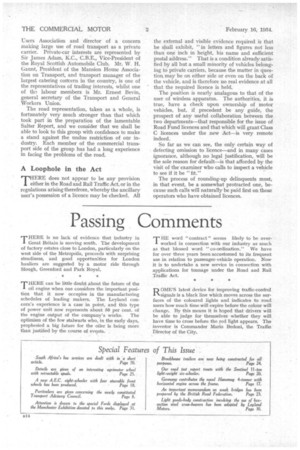The Transport Advisory Council
Page 23

Page 24

If you've noticed an error in this article please click here to report it so we can fix it.
IT has taken the Minister of Transport a long time to make up his mind as to the exact constitution of the Transport Advisory Council. This, however, is not surprising, for apart from the long list from which he has had to make a choice, there was the difficult task of forming a workable council from a variety of 'nterests, many of which are conflicting. Whether his selection is happy or not can be shown only by the quality of the work performed by the Council and the practical results obtained.
It is to be presided over by Lord Goschen, a chairman with excellent credentials, and to have the benefit of the advice and guidance as secretary of Mr. R. H. Tolerton, D.S.O., M.C., a well-known official of the Ministry who has had a great deal to do with the Road and Rail Traffic Act and its regulations. Direct representatives on the commercial side of road transport include Mr. Sidney E. Garcke, M.I.Mech.E., M.Inst.T., a well-known personality in road passenger-transport circles ; Mr. W. Edwards, M.Inst.T., President of the National Road Transport Employers Federation ; Mr. J. S. Nicholl, M.Inst.T., Senior Vice-chairman of the Road Haulage Association, and a director of an important haulage concern ; and Mr. S. N. Home, M.Inst.T., President of the Commercial Motor Users Association and director of a concern making large use of road transport as a private carrier. Private-car interests are represented by Sir James Adam, K,C., C.B.E., Vice-President of the Royal Scottish Automobile Club, Mr. W. H. Gaunt, President of the Mansion House Association on Transport, and transport manager of the largest catering concern in the country, is one of the representatives of trading interests, whilst one of tha labour members is Mr. Ernest Bevin, general secretary of the Transport and General Workers Union.
The road representation, taken as a whole, is fortunately very much stronger than that which took part in the preparation of the lamentable Salter Report, and we consider that we shall be able to look to this group with confidence to make a stand against the undue restriction of our industry. Each member of the commercial transport side of the group has had a long experience in facing the problems of the road.
A Loophole in the Act
T°THERE does not appear to be any provision I either in the Road and Rail Traffic Act, or in the regulations arising therefrom, whereby the ancillary user's possession of a licence may be checked. All the external and visible evidence required is that he shall exhibit, "in letters and figures not less than one inch in height, his name and sufficient postal address." That is a condition already satisfied by all but a small minority of vehicles belonging to private carriers, because the matter in question, may be on either side or even on the back of the vehicle, and is therefore no real evidence at all that the required licence is held. The position is nearly anaIagous to that of the user of wireless apparatus. The authorities, it is true, have a check upon ownership of motor vehicles, but, if precedent be any guide, the prospect of any useful collaboration between the two departments—that responsible for the issue of Road Fund licences and that which will grant Class C licences under the new Act—is very remote indeed.
So far as we can see, the only certain way of detecting omission to licence—and in many cases ignorance, although no legal justification, will be the sole reason for default—is that afforded by the visit of the examiner who calls to inspect a vehicle to see if it be "fit."
The process of rounding-up delinquents must, in that event, be a somewhat protracted one, because such calls will naturally be paid first on those operators who have obtained licences.




















































































